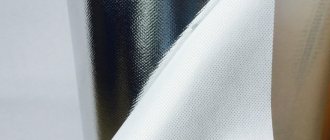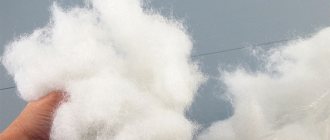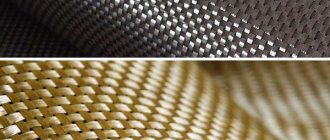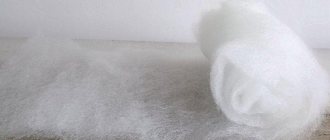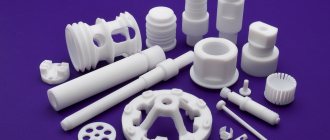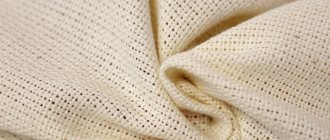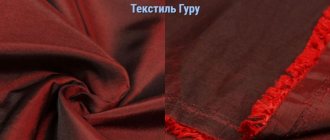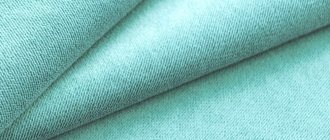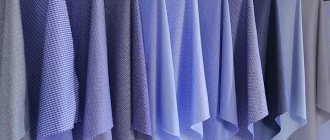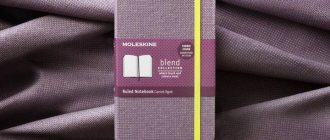Modern winter and demi-season clothing usually has insulation between the lining and the front surface. Its task is to retain heat; it must be breathable and as light as possible. Many insulation materials have such properties, and thermofin is only one of them. What advantages does this product have over analogues and how to choose its density correctly?
Manufacturing
The successful proportion of price and quality encourages an increasing number of manufacturers of demi-season and winter clothing to choose insulation such as thermofin . This is the result of research by Russian scientists who used Finnish technologies for creating materials for low temperatures. The new development went into wide production in 2009.
Termofin
is made from primary raw materials ; it includes both simple highly crimped fibers and bicomponent ones.
The latter have two elements: the core and the shell. When heated in an oven, the casing melts and adheres to the highly crimped fiber. But the core remains intact due to its increased refractoriness. The result is a material with a three-dimensional structure, filled with many air chambers , strong and very light.
Plus, thermofin fibers are combed both vertically and horizontally, which reduces thermal conductivity and increases volume . The manufacturing process itself is performed on high-precision German equipment. It is calibrated down to the minute and automated so that it is almost independent of the human factor.
At the output, deviations from the declared parameters in terms of weight, length and volume of the roll are no more than 2%, with the permissibility according to GOST up to 7% . This textile fabric also received the International Quality Certificate “Eco-Tex Standard 100” .
This is interesting: Needle-punched fabric - what is it: description, types
Reviews about durability and environmental friendliness
It should also be noted that it dries quite quickly, which is due to the lack of the ability to absorb moisture. Modern consumers also choose this insulation for the reason that it is environmentally friendly. Various impurities are not used in the production process; the technology involves the use of granules of primary raw materials. Termofin has the Eco-Tex Standard 100 certificate, which confirms the international quality standard. Today, thermofin (clothing insulation), reviews of which are almost always only positive, is used very often, during operation it does not accumulate unpleasant odors, among other things, it can be used by people who suffer from allergies. The material is hypoallergenic. You can count on wear resistance and a long service life. If a product containing the described insulation is used carefully, then you can count on durability and preservation of its original shape, as well as appearance. In addition to all the above advantages, we can also highlight the affordable cost; this insulation has no equal in the price segment.
Varieties, to what air temperature they last
Depending on the thickness and ability to withstand low temperatures, thermofin insulation can be divided into several types (100, 150 and 200), up to what temperature they are operational - in the table below, reviews - later in the article.
| Type of insulation | Thickness | At what temperature is it operational? |
| Termofin 100 | 1.20 mm | -15°С |
| Termofin 150 | 2.20 mm | -22°С |
| Termofin 200 | 2.70mm | -30°С |
| Termofin 100 and 100 (two-layer) | 2.40 mm | -30°С |
| Termofin 100 and 150 (two-layer) | 3.40 mm | -35°С |
| Termofin 150 and 150 (two-layer) | 4, 40 mm | -42°С |
| Termofin 200 and 200 (two-layer) | 5, 40 mm | -55°С |
When making clothes, you need to consider what the surface and lining fabrics will be. They can provide additional protection from cold and wind.
Every year, modernized versions of insulation appear. So, in 2013, improved material Termofinn Plus . Its top layer is calendered with minimal fiber displacement, which makes it easier to cut the product.
A year later, clothing manufacturers were pleased with another new product called Termofinn micro . It is distinguished by a calendered “crust” and the presence of ultra-thin microfibers (up to 10 microns in diameter). They are 50 times more “graceful” than human hair and are surrounded by air, due to which the material “breathes”, but does not allow moisture to pass through from the outside, and also has antistatic properties.
“Thermofin” (insulation): to what temperature does this material warm the air?
Both demi-season and winter outerwear are sewn from it, depending on the density of the insulation (and it can be 100, 150 and 200 grams per m²). The Termofin insulation will not allow you to freeze even at a temperature of -55 ° C, and this is almost the limit for mid-latitudes, not to mention average winter temperatures.
Autumn-spring jackets are made from material with a density of 100 grams per m², which are very warm and cozy in inclement and damp weather. There is an additional plus: since this insulation has water-repellent properties, it is not afraid of rain or wet snow.
What qualities does he have?
- Elasticity and softness . These parameters are achieved by the fact that most types of thermofin do not involve calendering, that is, rolling with hot rolls in order to compact the material or make it thinner. If a type of insulation requires such a process, then it is carried out using special technologies that do not reduce the quality of the product.
- Convenient volume and light weight . These indicators make it possible to work intensively in clothes with thermofin. With a thickness of 1.2 to 2.7 mm, the warm layer will not cause the product to become bulky.
- Water repellent properties . Termofin does not allow water to pass through and does not attract odors. Clothes dry quickly with it. At the same time, thanks to the air chambers, the textiles “breathe” and do not provoke sweating.
- High level of heat saving . It more than doubles the requirements of GOST R 12.4.236-2007.
- Durability .
If handled correctly, the product will last more than 10 years; it holds its shape well even after going through many washes. After five cleaning procedures, the shrinkage is approximately 0.2%, which is 10 times less than that prescribed in GOST. You can roll clothes: thermofin restores its shape well after being compressed. - Affordable price . In online stores you can purchase canvas from 150 rubles per linear meter. Accordingly, clothes using it are inexpensive. So, when buying a jacket on a thermofin, you can spend 2,000 rubles.
- Ease of cutting and sewing . The fabric does not crumble when cut, does not “creep” when sewing, does not flatten when stitching, and easily takes the desired shape. This helps save time on making clothes.
- Environmental friendliness and safety . As already mentioned, only primary raw materials are used in production. These are petroleum pellets, not recycled waste. Therefore, clothing with thermofin is recommended even for newborns or people suffering from allergic reactions.
What materials and insulation are used in the manufacture of such workwear as a women's winter suit, read in the next article.
Read about what the uniform for police officers should look like in this material.
And we’ll tell you here how to choose a uniform for a car wash, taking into account the image of the establishment.
Types of insulation for outerwear
For winter outerwear, Finns use natural and artificial insulation. Heat preservation is the main task that must be achieved taking into account the influence of different weather conditions. The extent to which the insulation can cope with this depends on temperature indicators, climate and the quality of the materials used.
Natural down is a classic among insulation materials
The down of waterfowl is used as natural insulation. The Finns use Arctic goose down in their models. The advantage of the material is natural thermal insulation. Outerwear with natural down can withstand even the most severe frosts - down to -40 °C. In terms of weight, natural down is slightly heavier than artificial insulation. Its advantages include the following properties:
- excellent thermal insulation properties;
- air circulation and hygroscopicity;
- strength and durability of the material;
- environmental friendliness and durability of use.
In the past, down myths used to be heard about possible allergies among users and the risk of dust mites and other pests in the jacket. Please note that before use in sewing outerwear, the insulation undergoes disinfection and special treatment. This completely eliminates possible disadvantages.
Artificial insulation - the era of high-tech materials
Conscious fashion and an environmentally friendly approach to creating clothes have prompted many brands to switch to the use of artificial insulation. Technological materials have made it possible to abandon the animal component in the production process.
#1 Zero Down
Zero Down is one of the newest technological insulation materials used in Finnish down jackets. Able to adapt to the ambient temperature, while being a light and thin material. The insulation removes excess heat when you are in a warm room, but does not let cold wind flow through when you walk down the street. This insulation is actively used by the Dixi Coat brand - read reviews about Zero Down.
#2 Solarball
Together with the technological Solarball insulation, clothing acquires the ability to heat up when exposed to sunlight. A little infrared radiation, a few minutes, and the jacket becomes +7 °C warmer. The insulation is used in Finnish down jackets of the Dixi Coat brand.
#3 Isosoft
Soft and well-retained Isosoft insulation has excellent heat-retaining properties. Its strengths are high breathability and ductility. Most often used in models aimed at autumn and eurowinter.
#4 Coffee Bean
And another technological invention is the use of carbonized particles of ground coffee in the composition of polyester. This technology is the basis of the Coffee Bean material. Effective heat retention, antistatic and antibacterial properties combined with light weight and softness - that's all there is to know about Coffee Bean. The insulation is used in models of the Finnish brand Reima.
Composition and structure of insulation
Jacket pattern with thermofinn
High domestic demand for thermal protective materials is due to harsh climatic conditions.
Residents of northern countries have similar needs. For a long time, all good quality insulation materials were imported.
In 2009, the Termoreal company, using Finnish technology and European equipment, launched the production of a new synthetic insulation, ThermoFinn.
Please pay attention! The German company Thermofin, which produces refrigeration and ventilation equipment, has nothing to do with insulation.
Thermofinn is made from thin polymer raw materials delivered from South Korea. 85% of the fibers have a tortuous shape and internal cavities along the entire length. 15% of the fibrous material has a bicomponent structure. There is an outer shell around the flexible inner core.
The technological process for producing insulation consists of several stages.
- At the first stage, the raw materials are weighed under the control of computer programs.
- Then the fibers are combed out in horizontal and vertical directions. The result is a homogeneous, ordered product.
- The next stage is heat treatment. When the fabrics are fused in furnaces, the outer shell of the bicomponent fibers softens, as a result of which they join at the points of contact. A three-dimensional structure is formed. The heating temperature is controlled automatically. Fluctuations in temperature can lead to a sharp deterioration in quality.
- During subsequent molding, under the control of computer programs, the procedure of trimming the edges and cutting the canvases to a strictly specified length occurs.
- At the final stage, the insulation is vacuumed and then sent to the warehouse.
This is how the basic classic modification of thermofinn is made.
In what areas is it used?
Nowadays thermofin insulation is used when sewing a wide variety of types of clothing . These are city jackets and coats for the off-season and winter, children's jackets and overalls, envelopes for newborns, and sports models. A variety of hats are produced using this insulation. It is popular as a filling for pillows and blankets and a warm layer in sleeping bags.
Manufacturers of workwear and uniforms are the leaders in orders for thermofin for their production . After all, it creates the necessary comfort during operation in a variety of conditions, even extreme ones.
Suits, jackets and overalls for drillers and installers, dockers and logistics handlers, uniforms for guards and security guards - representatives of many professions will appreciate the benefits of products with thermofin.
In workwear for harsh male professions, they also take into account not only a large gradation of weather indicators, but also the physical activity of workers, as well as the duration of their stay in the open air at low temperatures.
This is interesting: Holcon - what is it: mattress filler, description
Commercial properties of insulation
Environmental friendliness and safety. Termofinn does not accumulate odors and does not cause allergies. For its production, only primary raw materials are used - oil granules, and not processed recyclable materials mixed with garbage (glass shards, dirt, crumbs). Termofinn textile insulation has the International Quality Certificate “Eco-Tex Standard 100” for the 1st product category. Things using termofinn are safe even for kids.
Easy to cut and sew. The soft but elastic structure of the insulation does not crumble or climb. Practically does not flatten when quilting.
Excellently retains elasticity and shape after washing. Consisting of a low-melting shell and a polyester core, biocomponent fibers act as glue, so a highly crimped and thermally multiply bonded insulation structure is formed. Recovers well after compression. Shrinkage after 5 washes is 0.2%, which is 10 times less than GOST requirements.
Plasticity and softness due to the absence of a calendering “crust” sealing the upper and lower layers.
Light weight and excellent heat-saving protection in severe frosty weather, exceeding by more than 2 times the requirements of GOST R 12.4.236-2007. A huge number of air pores formed by the fibers reliably retain heat.
Dries quickly due to good moisture resistance.
Unpretentious clothing care:
- wash at 30°C with liquid detergents without bleach;
- gentle spinning and drying away from heating devices;
- Dry cleaning possible.
Reviews of some product properties
In the process of making warm clothes today, thermofin (insulation) is often used. To what temperature (reviews will help you understand) the material protects a person from the cold was mentioned above. This information will help you when purchasing products. However, it is also important to know that the material perfectly retains its shape and elasticity even after many washes, which is due to its structure. Due to the fact that biocomponent fibers consist of a polyester core and a low-melting shell, the material is a multi-fixed structure that is thermally stable. Users emphasize that after 5 washes the material shrinks by 0.2%, which is 10 times less compared to the parameters presented by state standards. This perfectly characterizes the material that was described above.
New fabric versions
The manufacturer has modernized the classic version of termofinn insulation and created 2 new versions of the product.
Termofinn Plus appeared on the market in 2013. It has a calendered surface with minimal fiber migration. The insulation features a more simplified cutting process.
In 2014, termofinn micro insulation with a calendered “crust” was introduced; it is certified according to GOST standards. The main feature is the presence of ultra-thin microfibers. Each microfiber, which is 50 times thinner than a hair and up to 10 microns in diameter, is surrounded by an air layer. Breathable material does not absorb moisture and remains dry. In addition, it has antistatic properties.
Previous
Modal fabric - what kind of fabric is it and where is it used?
Next
Chintz, what kind of fabric is it - its description and analogues
Thermofin insulation (termofinn) - temperature conditions and properties of clothing
In Russia, with its cold climate, warm but light outerwear has been and will be in demand among consumers. The urgent problem of creating high-quality, but inexpensive, insulating textile material to replace imported Russian production was successfully solved in September 2009.
Synthetic insulation termofin (termofinn) has no analogues on the domestic clothing market among textile offerings in the same price category. The new product advantageously combines Finnish technologies, German equipment and Russian production.
High-tech production
The company , owner of the Termofinn® brand, organized in the Odintsovo district of the Moscow region an ultra-modern automated production line with a length of 100 meters, which occupies 2 floors of a building and meets the requirements of Western standards.
The Termofinn manufacturing process, which is precise down to the minute, absolutely eliminates the influence of the human factor. Stages of unique production:
- First, the raw materials are supplied to the conveyor, where an accurate computer measurement of the amount of components takes place and they are mixed in a strictly fixed percentage.
- Vertical and, most importantly, horizontal (only from this Russian textile manufacturer) combing of fibers. The procedure gives the mass evenness and vertical, visible in cross-section, ordering of the fibers (approximately 80%). Due to this, Termofinn receives volume and low thermal conductivity.
- Melting in an oven at a certain temperature. The shell of the biocomponent fiber, when heated, twists and glues with conventional fibers, forming a three-dimensional three-dimensional structure. It is very important not to overheat the fibers, otherwise the output will be hard insulation and vice versa.
- Trimming the edges of the finished material using cutting shafts. Thanks to it, Termofinn rolls have a clear width, which is very convenient for cutting. The laser meter then adjusts the length of the web specified by the computer program down to the centimeter.
- Vacuum packaging of the goods is provided before direct shipment to the warehouse, which preserves the softness and structure of the insulation and protects it from caking.
Description, technical specifications
Polyester fibers produced in South Korea are used as raw materials for Termofinn insulation. Of these: 85% (the main part of the composition) are hollow, highly crimped and 15% are biocomponent whole fibers.
Specifications:
- the material is available in densities of 100, 150 and 200 g/sq.m.
- The thickness of the blade varies: 1.2, 2.2 and 2.7 mm.
- depending on the thickness and number of layers, it is effective for protection at low temperatures from -15 to -55°C.
The actual weight, length and thickness of the roll have deviations not exceeding 2% from the declared product data. For comparison, according to GOST, up to 7% is allowed. The stability of the characteristics is beneficial when calculating the quantity of ordered material and its cutting.
Commercial properties of insulation
Environmental friendliness and safety. Termofinn does not accumulate odors and does not cause allergies.
For its production, only primary raw materials are used - oil granules, and not processed recyclable materials mixed with garbage (glass shards, dirt, crumbs).
Termofinn textile insulation has the International Quality Certificate “Eco-Tex Standard 100” for the 1st product category. Things using termofinn are safe even for kids.
Easy to cut and sew. The soft but elastic structure of the insulation does not crumble or climb. Practically does not flatten when quilting.
Excellently retains elasticity and shape after washing. Consisting of a low-melting shell and a polyester core, biocomponent fibers act as glue, so a highly crimped and thermally multiply bonded insulation structure is formed. Recovers well after compression. Shrinkage after 5 washes is 0.2%, which is 10 times less than GOST requirements.
Plasticity and softness due to the absence of a calendering “crust” sealing the upper and lower layers.
Light weight and excellent heat-saving protection in severe frosty weather, exceeding by more than 2 times the requirements of GOST R 12.4.236-2007. A huge number of air pores formed by the fibers reliably retain heat.
Dries quickly due to good moisture resistance.
Unpretentious clothing care:
- wash at 30°C with liquid detergents without bleach;
- gentle spinning and drying away from heating devices;
- Dry cleaning possible.
Practical use
Termofinn is widely used in the following areas:
- sewing various demi-season and winter types of clothing (sports, fashion, children's, uniforms) and hats;
- insulation of tourist sleeping bags;
- filling blankets and pillows.
Termofinn’s corporate identity is successfully emphasized by hanging labels on finished products, which Termoreal LLC supplies clothing manufacturers free of charge. The letter “O” in the logo, stylized in the image of a bullfinch, which does not mind severe frosts, and the combination of blue and red colors, symbolizing warmth and cold, emotionally convey the main qualities of Termofinn products.
New fabric versions
The manufacturer has modernized the classic version of termofinn insulation and created 2 new versions of the product.
Termofinn Plus appeared on the market in 2013. It has a calendered surface with minimal fiber migration. The insulation features a more simplified cutting process.
In 2014, termofinn micro insulation with a calendered “crust” was introduced; it is certified according to GOST standards. Feature – the presence of ultra-thin microfibers. Each microfiber, which is 50 times thinner than a hair and up to 10 microns in diameter, is surrounded by an air layer. Breathable material does not absorb moisture and remains dry. In addition, it has antistatic properties.
Source: https://wearpro.ru/spectkani/uteplitel-termofin.html
Let's compare different materials
Synthetic insulation has many advantages. In some respects, they are even superior to natural fabrics. Here's what's interesting about some of them. So, thermofinn or:
- Thinsulate. One of the warmest fabrics, it was created in America for astronaut suits and has unique thermoregulating properties. The material consists of myriads of hollow fibers, each of which is tens of times thinner than a human hair.
- Yunsen. This product of the Russian company of the same name will provide warmth and comfort even at a temperature of -25
OC. Its density is 200 g/m
2
. Made from primary raw materials with the addition of biocomponent fibers.
- Thermium. This excellent heat-return material is manufactured by the Belgian company Libeltex. It consists of an aluminum film with polyester fibers woven into it, which perfectly reflects human heat.
- Isosoft. Also a product of Libeltex. This is the thinnest of all synthetic insulation materials. It consists of hollow balls. Light and airy material is 3-4 times warmer than padding polyester.
- Hollophan. The name of the insulation consists of the English word hollow – “hollow” and the Fanema company that created it. The structure of the material contains hollow polyester fibers. Twisted into elastic springs, they hold their shape perfectly. The products are highly wear-resistant.
Types and applications
Thermolite® material is used for the production of outerwear for men, women and children, sportswear, shoes and equipment, and underwear.
There are several types of thermolight, each of them has a special property that allows it to be successfully used in a particular area.
Extreme®
The warmest in the line. Made from three types of fibers:
- The material is based on microscopic fibers that help maintain temperature;
- thermally layered fibers provide density and additional insulation;
- special 3-D spiral-shaped fibers ensure heat retention and rapid moisture removal thanks to the best heat insulator contained inside - still air.
The combination of fibers gives the material special lightness, elasticity and strength, and allows it to withstand mechanical loads, including repeated washing. Used as filling for sleeping bags and sportswear. When storing such products in a tightly rolled state, the quality of the insulation does not suffer - it quickly restores its original volume.
Read about: Aloe Vera filler
Extra®
Second in warmth. The basis is made up of spiral-shaped fibers, each with three holes. Very elastic, its properties are close to natural goose down, and even surpasses it in thermal insulation.
Used to insulate outerwear - jackets, suits and overalls.
Micro®
Consists of very fine fibers, compact and warm. The thinness of the layer allows it to be used for insulating products that would be hampered by excess volume - gloves, hats, sleeping bags.
Plus®
Material consisting of two types of fibers:
- thin;
- with holes.
Very soft and comfortable, retains heat even in conditions of high humidity, quickly removes moisture and gives the body a feeling of dryness and comfort.
Used for clothing intended for active sports.
Active®
Compact and very flexible. Ideal for sports outerwear as it can stretch and does not restrict freedom of movement. It is used to produce comfortable and almost weightless ski suits.
Base®
The material consists of thermolight fibers, wool and lycra. Used for the production of thermal underwear. With increased physical activity and sweat, ordinary underwear gets wet, and the human body needs to allocate additional energy to evaporate this moisture. This is where heat loss occurs and a person begins to freeze.
In materials with thermolight, the synthetic layer adheres to the body, absorbs all moisture when sweating and instantly transfers it to the top layer, allowing the skin to remain dry. Further, the wool also quickly removes moisture out. The body remains completely dry and heat is retained.
Pants, long-sleeve T-shirts and socks made from this material can be used even in the harshest climatic conditions.
Shoes
Shoes with this heat insulator are used for winter sports, hunting, fishing, etc.
Clean, wash, dry
The insulating material is very easy to clean. It can be dry cleaned. Products made from thermofinn are washed at a temperature of 30
O
Without the use of bulk detergents and bleaches. It is recommended to squeeze them gently. You need to dry things away from heating devices.
Read about: Ecofiber
This magnificent insulating material will keep you warm even in the most severe frosts. And your sleep on soft pillows under the lightest blanket filled with thermofinn will be long and serene.
Where to buy Certificates
| Termoreal LLC | 109316, Moscow, Volgogradsky prospect, 47, office 409 | Tel/Fax (general) |
Thermofil - synthetic insulation
Thermofil (Thermofil) is a new synthetic bulk filler with excellent thermal insulation properties. Lightweight, soft and warm, it is durable, resistant to compression, breathable and does not absorb moisture. The creators of the new insulation used the latest technology for processing polyester fiber, which Thermofil is made of. Each microscopic fiber has a crescent-shaped cross-section. The cavity inside the fiber significantly reduces the weight of the material and improves its hygienic and heat-insulating properties. Until recently unknown to anyone, today Thermofil occupies a worthy place among the substitutes for natural fluff.
Thermofil insulation meets all modern requirements, while it is much cheaper than most imported analogues, which is important for the Russian consumer.
The BASK company introduced Thermofil to the domestic market for the first time, using the new material as insulation for sleeping bags.
Specialists from SPF BASK began searching for insulation for inexpensive, but warm and comfortable tourist sleeping bags two years ago. Not every Russian tourist can afford the well-known imported Thinsulate, and it was fundamentally decided not to use traditional cheap padding polyester because of its low consumer qualities. We monitored the market and found an enterprise in Belarus that set up experimental production of Thermofil in pilot batches.
To improve water-repellent properties and increase volume, the fiber is treated with a special compound. Thanks to this treatment, the material effectively retains heat, does not lose its warming properties at high humidity, and retains its volume during repeated deformations.
Trial tests of Thermofil carried out by BASK specialists gave very good results. However, we did not limit ourselves to preliminary tests, entrusting more serious research to the staff of the laboratory of special materials of the Research Institute of the Ministry of Defense of the Russian Federation. Two samples of materials, Belarusian Thermofil and American Thinsulate, were subjected to additional tests, including strength and durability.
Microphotographs showed that the structure of the Thinsulate material, made from the finest fibers, is characterized by pronounced layering and dense weaving. Thinsulate requires careful storage and is sensitive to the quality of the detergent and the temperature of the washing cycle.
Compared to Thinsulate, Thermofil fiber is stiffer and thicker. The weave structure of this fiber is more sparse and uniform in the volumetric weave. Thermofil is more resistant to deformation, which means that products made from it are shape-stable and have low creasing.
However, Thermofil also has a number of disadvantages. As can be seen in the photographs, there are inhomogeneities in the structure of the insulation, some of which - fragments of compacted curling - improve the overall parameters of the material, while others - nodal structures (rarely encountered) - worsen the heat-insulating properties of the material.
Nevertheless, we were pleased with the general conclusions. Of course, Thinsulate is warmer and lighter than Thermofil, but the strength characteristics and durability of the Belarusian material are higher. In terms of warming and performance properties, Termofil is certainly significantly superior to synthetic winterizer. The price of sleeping bags made from new insulation is remarkable.
At the beginning of 2001, SPF BASK moved from trial batches to mass production of sleeping bags filled with Thermofil, and outdoor enthusiasts appreciated its properties. Tens of thousands of Russian tourists have already chosen tourist sleeping bags with Thermofil insulation!
Where and how was thermofin invented and produced?
Russian thermofin is produced, but the technology for its production belongs to Finnish engineers. Specialists from TTI University (Tampere, Finland) and Termoreal have been working on the creation of this insulation for a long time. The task was to invent a material specifically for the climatic conditions of Russia. As a result, clothes with this filler can provide warmth at fairly low temperatures – down to –50°C.
Later, termofinn passed the relevant tests and was highly praised by specialists from Oeko-Tex Standard 100, a global organization for testing and certification of textile products. This material is assigned the highest class I, which means it is suitable for use by children under 2 years of age. Now thermofin is produced on an industrial scale using the latest German-made equipment.
This material has a wide range of applications. Today it is used for sewing winter clothes for children and adults, and products for sports. They make uniforms out of it for employees of various companies who are forced to spend their working hours outside. In addition, thermofin is used to fill bedding - pillows, blankets, mattresses, as well as products for newborns (warm covers for strollers, baby carriers, etc.).
Advantages and disadvantages
Termofin is an almost ideal insulation material; its advantages include:
- softness, elasticity, lightness;
- high air conductivity;
- waterproof;
- durability. The material does not lose its properties for 10 years;
- high degree of heat retention. Filler with a density of 200 is operated at a temperature of minus 50°C;
- does not accumulate static electricity;
- does not cause allergies.
The material shows a minimum shrinkage of 0.2% after several washes.
Types of material
There are several main types of Thermolite material:
- Active - the material has a minimum volume, while completely retaining body heat.
- Base - used for the manufacture of sports underwear, due to the fact that it perfectly retains heat even with intense moisture, dries quickly and prevents chills. It has minimal weight, can be washed perfectly in a washing machine without shrinking and retaining its shape.
- Extreme – for extreme frost, the warmest of all types. It has three types of fibers in its structure: thin, thermally bonded, and spiral-shaped hollow. Thanks to this structure, the material is warm, light and resistant to deformation. This type of insulation is very durable and warm, perfectly restores its shape, and can be washed in a washing machine and dried. Used for making sleeping bags, sportswear and regular clothing.
- Extra is a more budget option than the previous one with excellent characteristics. Its structure has hollow fibers twisted in the form of a spiral, in which there are three holes that improve thermal conductivity. In terms of thermal insulation it is in second place after Extreme, 20% warmer. than goose down. It has just the perfect combination of cost, volume and weight.
- Micro – minimal volume of material provides excellent thermal insulation. It does not absorb odors and is used in the manufacture of sleeping bags and gloves.
- Plus is a special material for making winter clothing for severe frosts. About 80% of the material is improved polyester, has minimally fine fibers and fibers with holes. Thanks to this structure, it is very soft, does not cause allergies and is resistant to mechanical stress, warming even when wet. This material can be washed and dried in a washing machine many times without affecting its quality.
Thermolite insulation has several varieties: Extreme, Extra, Micro, Plus, Active. These insulation materials are widely used for the manufacture of insulated sportswear, and also as insulation for sleeping bags.
THERMOLITE ACTIVE
Thermolite ® Active is a lightweight, compact insulation that provides maximum warmth with minimal volume. Even when wet, it remains lightweight. Thanks to ADVANSA fibers that are hollow on the inside and retain air, Thermolite Active insulation maintains optimal body temperature. In addition, it dries quickly, 20% faster than similar insulation and 50% faster than cotton . Thermolite Active is an ideal option for sportswear, due to its lightness, and most importantly, it does not restrict movement.
THERMOLITE EXTREME
The warmest insulation in the Thermolite® family is Thermolite® EXTREME . Thermolite® EXTREME consists of a mixture of three types of microfibers (thin filaments, thermally bonded filaments and bulk hollow spiral filaments). Each type of fiber is responsible for the following properties: strength, ability to retain heat and elasticity (recovery after compression). This type of insulation is characterized, first of all, by high thermal insulation and high elasticity. Also, this insulation is so durable that it can withstand machine washing and drying well. Used as insulation for sportswear and sleeping bags.
THERMOLITE EXTRA
Thermolite® Extra is the second most thermally insulating material from the Thermolite® line of synthetic insulation materials. The material is based on spiral-twisted fibers, each of which has three holes for better thermal conductivity. This material is approximately 20% warmer than goose down with an FP value of 550. It has a high degree of elasticity.
THERMOLITE MICRO
Thermolite® Micro consists of superfine fibers that provide good thermal insulation in a smaller volume. Thus, this material becomes more compact, which is optimal for use in gloves and sleeping bags. Thermolite® Micro does not absorb odors.
This very soft and comfortable material is mainly used to make sportswear.
THERMOLITE PLUS
Thermolite® Plus is designed specifically to insulate clothing designed for cold weather. It is made from 80% recycled polyester. This insulation is soft, has high mechanical resistance, and is hypoallergenic. It continues to warm in an important condition and is machine washable and dryable. Thermolite® Plus insulation retains its characteristics even after a large number of washes. This soft and comfortable material is used to make sportswear.
Thermolite Plus - used mainly for clothing, including the HXP brand. Thermolite Plus consists of two types of fibers: very fine and holey fibers. The special structure of the fibers allows us to talk about good thermal insulation even in a wet state, as well as high wear resistance of the material. This very soft and comfortable material is frost-resistant down to -30. When combined with membrane tissues, this threshold increases significantly.
How to take care of things
Caring for products with such insulation is quite simple. Wash them at a temperature within 30°C, preferably on a delicate cycle. The spin speed is no more than 600 rpm. You can wash it by hand or take it to the dry cleaner.
| Can be used | Can not use |
|
|
The product should be dried in a ventilated room or in the open air. Do not place it on the radiator or try to dry it with a hairdryer.
What kind of insulation in winter clothes is Thermax?
- Auto and motorcycle Motorsport
- Car insurance
- Cars
- Service, Maintenance, Tuning
- Service, care and repair
- Choosing a car, motorcycle
- Traffic police, Training, Rights
- Registration of auto-moto transactions
- Other Auto Themes
- LEISURE AND ENTERTAINMENT Arts and entertainment
- Military service
- Health
- First meal
- Friendship
- Computers
- Hometasks
- Independent holiday
- Work environment
- Parenting
Scope of application: what to sew
Holofiber is available in 3 types: granules-balls, canvas and plates.
- Granule ball is the most common and familiar type of filler. The fibers twist to form balls ranging in size from a pea to a ping pong ball. This form of material holds its shape well, does not get knocked down or deformed - it is used to stuff pillows, toys, used as a filler for blankets and gives a three-dimensional shape to decorative items.
- Non-woven fabric. Holofiber in sheets is available in different thicknesses from 60 to 4000 gm.sq. The thinnest canvas is used in landscape design. Fabrics with a density of 100 to 300 gm/sq are used as insulation for clothing. Denser fabrics, due to their thickness, density and elasticity, are excellent for making mattresses and upholstered furniture. There are three main types of furniture holofiber: there are also hard fabrics (hard) for creating a frame and flooring, medium (medium) for the top layer and soft (soft) for quilted elements and decorative elements.
- Plates (layers, mats) are produced for construction needs; they are an excellent insulation and sound insulator. Both soft and hard pressed mats are available.
Different types of holofiber are also used in light industry, mechanical engineering, the space industry and aviation.
Thermofiber of various densities and thicknesses is used in various fields. Due to its lightness and high level of thermal insulation ability, it is used to sew:
- Outerwear.
- Home textiles.
- Furniture covering.
Use allows you to significantly reduce the weight and volume of the finished product, which is important when sewing outerwear. Find out about the knitwear catalog from Beloshveyka Raskazovo at this link.
In mattresses
Bulky nonwoven fabric is often used to make mattresses and flooring. The fiber has a high level of compression, resembling the action of springs. This feature gives the mattress an additional orthopedic effect.
We suggest you read: How and how to remove old paint from a wooden surface?
Durable and wear-resistant fabric with a density of 750-800 g/m2 has a long service life and has good heat transfer properties. The fibers ensure air circulation, making mattresses made from this material suitable for children and people with allergies and bronchial asthma. For people with an allergic reaction to certain types of fabric, clothes are also made from nettle.
Areas of application
Termofinn is insulation with good thermal conductivity, providing protection from even extreme cold.
The material is used for sewing the following types of clothing:
- for Sport;
- for children;
- special forms.
Termofin is also used for sewing uniforms, hats, and sleeping bags. For a demi-season wardrobe, take an option with a density of 100-150 g/m², for a winter wardrobe - 250-430 g/m².
It is also used as a filler for bedding, and due to its environmental friendliness, it is used to make warm clothes for newborns.
Production stages
- The computerized system mixes bicomponent and conventional high-crimp fibers in the correct proportions (15% and 85%).
- The mixture is sent to a container where it is combed both vertically and horizontally. Thus, the output material is uniform, without lumps or compactions.
- Next, everything is placed in a melting furnace, where, under the influence of high temperatures, ordinary and bicomponent fibers are glued together, forming very strong compounds. The holding time is very important here, because any deviation in one direction or another will spoil the material, making it either too hard or too loose.
- Sharp knives trim uneven edges to width.
- The finished material is rolled into rolls.
Description of fabric, cost
So, what is polyester in jackets, what is such a filler? This, if you don’t go into details, is a loose mass of a huge number of very thin polyethylene fibers, movably fastened together. The air that is trapped inside it retains the heat generated by the human body. Moreover, the volume of this air in the thickness of the polyester insulation directly determines how effective the latter will be.
- Simple polyester fillings for jackets, “working” according to the principle “thicker layer - more air cavities in the weave of fibers - better heat retention.” These are padding polyester, padding polyester, holofiber, etc. They will not cost much at all. The thinnest padding polyester, for example, will cost about 200 rubles. per linear meter.
- More modern polyester insulation. They are more difficult to produce and cost more, but are more efficient in operation. Manufacturers have achieved a reduction in the required filler thickness due to the special structure of the fibers and the addition of calender layers on one or both sides. The lower price level for such materials is 250-350 rubles (various fleeces) per 1 linear line. m., upper – 2500 rubles (branded Polartek, USA).
Composition: what is thermofin insulation made from?
It is made of highly twisted and bicomponent fibers. They are similar to swan feathers, but are a completely synthetic material. Insulating non-woven fabric is made from polyester and consists of a huge number of tiny polyester-based fibers. Small voids in the structure of the material ensure its lightness and breathability. The small size of the cavities prevents moisture from entering.
During production, the bundles are shaped into a slightly spiral shape, which gives them greater flexibility. This allows the insulation to retain its shape for a long time, preventing the fibers from sticking and tangling. The material acts as an insulator due to the formation of an air gap in the spirals.
Isosoft – European quality
In 2003, the Belgian company Libeltex, which develops and produces non-woven products made from synthetic fibers, patented an innovative material called “isosoft”.
Isosoft consists of tiny polyester balls, the space between which is filled with air. It is this air gap that makes the material surprisingly warm.
The outside of the insulation is covered with a two-layer polymer coating, which completely prevents cold air from getting under the clothes. By not allowing heat to penetrate outside, isosoft, at the same time, does not create a “greenhouse effect”, since all excess moisture has a free exit through the pores of the material. Isosoft is available in different densities, which allows it to be used in clothing for different seasons:
- 50 – 75g/m2 – for demi-season clothing;
- 100 – 160 g/m2 – for late autumn and early winter;
- 250 – 300 g/m2 – for severe winter frosts.
In general, the temperature range at which you can feel cozy and comfortable in clothes with isosoft ranges from 10 to -300C.
